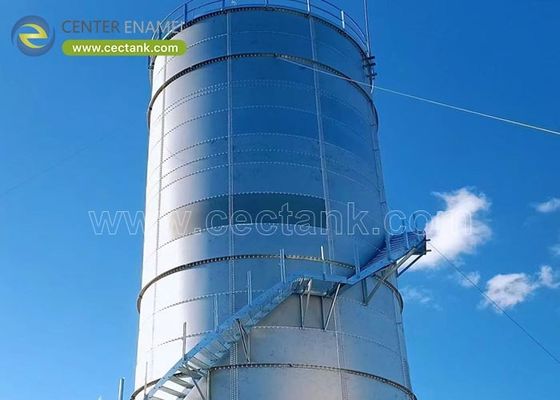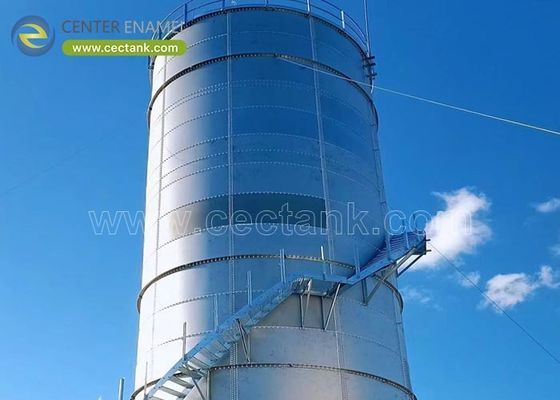-
鋼タンク に 溶かさ れ た ガラス (419)
-
ステンレス鋼 タンク (410)
-
融合はエポキシ タンクを結んだ (424)
-
鋼鉄タンク (321)
-
アルミニウム ドームの屋根 (872)
-
廃棄物 貯蔵 タンク (226)
-
溶接された鋼タンク (297)
-
圧力容器 (295)
-
嫌気性のダイジェスター (201)
-
産業水漕 (349)
-
ガラスで覆われた鉄タンク (180)
-
ボルトで固定された鋼鉄タンク (181)
-
沈積物の貯蔵タンク (115)
-
バイオガスの貯蔵タンク (173)
-
流出物 貯蔵タンク (133)
-
農業用水貯蔵タンク (179)
-
消防水タンク (166)
-
穀物 貯蔵 所 (130)
-
バイオガス プロジェクト (349)
-
排水処理のプロジェクト (270)
-
双面膜 の 屋根 (223)
|
詳細情報 |
|||
製品説明
米貯蔵用ステンレス鋼タンク:市場全体での衛生性、耐久性、価値
米は数十億人にとって主食であり、品質、安全性、一貫性が農場から食卓までの価値を牽引しています。貯蔵は、穀物の完全性を維持し、水分の移動を制御し、害虫や汚染から保護する上で重要な役割を果たします。ステンレス鋼タンクは、清潔さ、構造的な復元力、ライフサイクル経済性の魅力的な組み合わせを提供し、小規模な地域製粉所から大規模な輸出ターミナルまで、現代の米施設に適しています。Center Enamelのステンレス鋼貯蔵ソリューションは、高度な材料科学と精密なエンジニアリング、ターンキー展開を融合させ、収穫から加工、流通まで米を保護します。
世界をリードする貯蔵タンクメーカーとして、Center Enamelは、ガラスライニング鋼(GLS)タンク、フュージョンボンドエポキシタンク、ステンレス鋼タンク、亜鉛メッキ鋼タンク、アルミニウム測地線ドーム屋根、世界中のお客様向けの廃水およびバイオガスプロジェクト設備を提供できます。
| カスタマイズされた貯蔵タンクの構成 | ||||
| 貯蔵タンク | 容量 | 屋根 | 用途 | 設計要件 |
|
GLSタンク SSタンク フュージョンボンドエポキシタンク 亜鉛メッキ鋼タンク 溶接鋼タンク |
<1000m³ 1000-10000m³ 10000-20000m³ 20000-25000m³ >25000m³ |
ADR屋根 GLS屋根 膜屋根 FRP屋根 トラフデッキ屋根 |
廃水処理プロジェクト 飲料水プロジェクト 都市下水プロジェクト バイオガスプロジェクト 消火用水貯蔵プロジェクト 石油貯蔵プロジェクト |
給排水システム 耐震設計 耐風設計 避雷設計 タンク断熱設計 |
廃水処理プロジェクト設備供給
| 前処理設備 | 資源利用システム | 汚泥処理システム | その他の設備 |
|
機械式バースクリーン 固液分離器 水中ミキサー |
ガスホルダー ボイラーシステム ブーストファン バイオ ガス発生器 トーチシステム 脱水および脱硫タンク |
PAM統合投与装置 スクリュー汚泥脱水機 スラリー分離遠心分離機 |
汚水ポンプ 泥スクレーパー 水中汚水ポンプ 三相分離器 |
米貯蔵にステンレス鋼を選ぶ理由
- 衛生性と清掃性:ステンレス鋼の滑らかで非多孔性の内部は、穀物の残留物と微生物の温床を最小限に抑えます。これにより、バッチ間の衛生管理が簡素化され、食品安全認証と輸出コンプライアンスに不可欠な厳格な品質管理体制がサポートされます。
- 気候変動に対する耐食性:米の貯蔵環境は、湿度の高い熱帯港から涼しい内陸施設までさまざまです。ステンレス鋼は、水分、洗浄剤、周囲湿度による腐食に強く、タンクの寿命を延ばし、過酷な気候でも完全性を維持するのに役立ちます。
- バルク貯蔵の構造的信頼性:米の貯蔵には、重いバルク荷重、積み込み/荷降ろし中の動的な動き、環境ストレスに耐えることができる封じ込めが必要です。米貯蔵用に設計されたステンレス鋼タンクとサイロは、堅牢なジョイントと安全なシールを備えた信頼性の高い封じ込めを提供します。
- 清掃性と検査:高い衛生基準に仕上げられた内装は、迅速な検査、清掃、メンテナンスを容易にします。この機能は、CIP(定置洗浄)戦略をサポートし、バッチ間のダウンタイムを最小限に抑えます。
- ライフサイクル価値:より長い耐用年数、メンテナンスの削減、安定した貯蔵条件は、特に高いスループットまたは複数年の貯蔵計画を持つ施設にとって、有利な総所有コストにつながります。
- 規制への適合:ステンレス鋼は、食品および穀物処理業界で広く受け入れられており、世界の品質システムおよび輸出要件に適合し、監査と認証を容易にします。
材料、仕上げ、設計の選択肢
- 材料グレード:304ステンレス鋼は、優れた耐食性と費用対効果により、食品グレードの米貯蔵の一般的な基準です。沿岸または腐食性の高い環境では、316/316Lステンレス鋼は、塩化物への暴露や積極的な洗浄体制に対する保護を強化できます。
- 内装仕上げ:研磨またはサテン仕上げは、清掃性と検査の容易さを向上させます。より光沢のある内装は、穀物の流れを視覚化し、ターゲットを絞った清掃が必要な残留物を特定するのに役立ちます。
- サイロとモジュール式タンク:米の場合、従来のサイロとモジュール式ボルト締めタンクシステムの両方が利用可能です。モジュール設計は、迅速な現場組み立て、スケーラブルな容量、収穫ピークと需要の増加に対応するための容易な拡張を提供します。
- 通気と気候制御:米の貯蔵は、水分と温度を管理するための制御された通気から恩恵を受けます。設計では、内部の清潔さや耐食性を損なうことなく、ファン、多孔質の床、ダクト、センサー、防塵対策を統合または収容する必要があります。
- シール、ガスケット、ジョイント:制御された環境を維持するために、食品グレードのガスケットと精密シールを適切に使用し、清掃とメンテナンスのためのアクセス性を確保します。
米貯蔵プロジェクトの主な設計上の考慮事項
- 容量計画と穀物の特性:正確な見積もりは、米のバルク密度、水分含有量の目標、および予想される収縮を考慮する必要があります。適切なサイジングは、腐敗のリスクを最小限に抑え、スループットを最適化します。
- 積み込み/荷降ろしのダイナミクス:効率的な排出経路、最小限の摩擦、コンベアおよびバケットエレベーターとのインターフェースは、取り扱い速度を向上させ、エネルギー使用量を削減します。
- 衛生管理と相互汚染の制御:複数の米の種類またはその他の穀物が施設を共有する場合、内部の形状とガスケット材料は、相互接触を最小限に抑え、清掃手順をサポートする必要があります。
- アクセス性とメンテナンス:戦略的に配置されたマンウェイ、はしご、レベルゲージ、検査ポートにより、封じ込めを損なうことなく、ルーチンチェック、清掃、メンテナンスが可能になります。
- 品質保証とトレーサビリティ:材料証明書、内装仕上げ仕様、QAテスト結果などのドキュメントは、監査、認証プロセス、および顧客の信頼をサポートします。
運用上の利点とライフサイクル価値
- 米の品質保持:清潔で耐食性の内装は、腐敗のリスクを軽減し、穀物の外観と製粉性能を維持し、バッチ全体で一貫した製品品質をサポートします。
- スループットとプロセスの効率性:滑らかな内面と計画された排出ルートにより、サイロ、製粉所、または処理ラインへの荷降ろし中の安定した流れが可能になり、ボトルネックが削減されます。
- メンテナンスと稼働時間:モジュール式ボルト締めアプローチは、ダウンタイムを最小限に抑えながら、迅速な拡張、移転、または改修をサポートし、生産スケジュールを維持します。
- 総所有コスト:ステンレス鋼貯蔵は、一部の代替品よりも初期費用が高くなりますが、耐久性、衛生管理、容量の柔軟性によるライフサイクルコストの削減は、多くの場合、魅力的なROIをもたらします。
品質保証と規制への適合
- 製造規律:堅牢なQAプログラムは、材料のトレーサビリティ、溶接とボルト締めの品質、内装仕上げの完全性、およびリークテストをカバーし、信頼性の高いパフォーマンスと監査の準備を保証します。
- 衛生基準:輸出市場と規制コンプライアンスをサポートするために、HACCP、GMP、および地域の食品安全フレームワークに準拠します。
- ドキュメントと認証:規制レビューと顧客のデューデリジェンスを容易にするために、材料証明書、コーティングまたは表面仕上げデータ(該当する場合)、およびQA記録を提供します。
地域および市場全体でのアプリケーション
- 製粉および加工サプライチェーン:米の貯蔵は、製粉所、米加工施設、および下流の包装業務の安定した投入品質をサポートします。
- 輸出および流通ハブ:国際貿易に関わる施設の場合、ステンレス鋼貯蔵は、バイヤーおよび国境当局が要求する衛生管理と品質管理を支えています。
- 気候に配慮した展開:湿度、高温、または季節的な雨のある地域では、ステンレス鋼貯蔵は、米の品質を維持するために、通気および気候制御システムと統合されています。
- 柔軟な展開:モジュール設計により、収穫サイクル、地域の需要、または施設の近代化プログラムに合わせて段階的な容量増加が可能になります。
Center Enamel:米貯蔵の信頼できるパートナー
- グローバルな展開と専門知識:Center Enamelは、ステンレス鋼およびガラスライニング貯蔵ソリューションにおける深い経験を持ち、複数の地域とセクターにわたるエンジニアリングおよびサービス能力を備えています。
- 統合ソリューション:ステンレス鋼米貯蔵を超えて、Center Enamelは、幅広いタンクシステムを提供し、施設全体およびサプライチェーン全体で一貫した貯蔵戦略を可能にします。
- エンジニアリング主導の実行:実現可能性調査と負荷計算から、現場での設置監督と試運転まで、このプロセスは、精度、安全性、および納期厳守を重視しています。
- アフターサービスとメンテナンス:積極的なメンテナンス計画、スペアパーツの入手可能性、およびフィールドサービスサポートは、最高のパフォーマンスを維持し、ダウンタイムを最小限に抑えるのに役立ちます。
設置、試運転、およびメンテナンスのベストプラクティス
- サイト準備:モジュールパネルをサポートするために、排水、ユーティリティ、および将来の拡張に注意を払い、堅牢な基礎または高架プラットフォームを準備します。
- 組み立てシーケンス:ガスケットの着座、ボルトのトルク、およびパネルの配置がメーカーのガイドラインに従うことを確認し、中断を最小限に抑えるために、段階的な設置アプローチを使用します。
- 衛生管理と試運転:貯蔵を開始する前に、内部基準と規制要件に従って、衛生サイクルと穀物品質テストを実施します。
- 継続的なメンテナンス:シール、ジョイント、内面、および全体的な構造的完全性の定期的な検査をスケジュールし、監査とパフォーマンスレビューのために詳細な記録を維持します。
経済的および持続可能性の考慮事項
- ライフサイクル経済性:より高い初期投資は、耐久性、メンテナンスの削減、および穀物価値の維持による長期的な節約によって相殺され、有利な総所有コストをもたらします。
- 持続可能性の利点:ステンレス鋼は高度にリサイクル可能であり、効率的な米貯蔵慣行は、ESG目標と顧客の期待に沿って、腐敗関連の廃棄物を削減します。
米貯蔵のための将来対応型ソリューション
米貯蔵用のステンレス鋼タンクは、衛生性、耐久性、スループット効率の魅力的な組み合わせを提供します。Center Enamelのステンレス鋼貯蔵ソリューションは、穀物の品質、規制コンプライアンス、およびスケーラブルな成長をサポートする堅牢な封じ込めプラットフォームを提供します。材料の選択、内装仕上げ、通気の統合、およびメンテナンス体制を地域のニーズに合わせて調整することにより、米の貯蔵は、サプライチェーンの回復力を強化し、収益性を高める戦略的資産となります。




